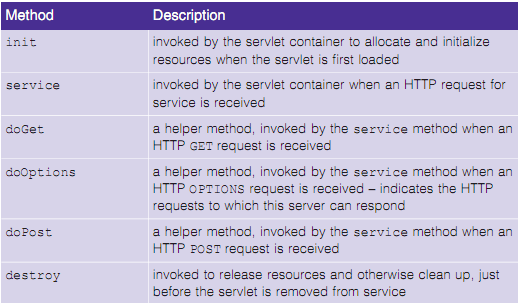How do servlets work:
We introduced the HTTP protocol for communication between web clients and web servers. We listed some of the important HTTP commands, such as GET and POST and gave some idea of the standard responses to these. We can now look 'behind the scenes' at what happens on the server side after the arrival of an HTTP request in order to construct the HTTP response.
We have discussed static web pages where the content does not change, unless the whole page is replaced. When a browser requests a static web page, using a GET command, the web server responds with HTTP header information (see Unit 9 for details) followed by the HTML content of the web page, together with any associated files, such as multimedia files or applet code.
When we want to do something more complex like using the web server to process some data from an online form or to construct a web page dynamically in response to some specific request, the web server can use one or more servlets. The servlet runs on the web server in a software environment known as a servlet container. The Tomcat system, which was developed as part of the open source Apache Jakarta project, is freely available software that provides servlet containers and a web server.
The servlet code accepts the HTTP request and any associated data, and constructs an appropriate HTTP response which is then sent back to the web client. If the request is successful, the response will mainly consist of a web page, possibly constructed dynamically by the servlet. In this way, servlets can return web pages that are adapted to the information supplied by the user, or containing information retrieved from other sources, such as a database.
Figure shows an example of a web client sending an HTTP request to a web server. The web server is running one or more Java servlets and also interacts with a database server and a remote web server. Using the information from these sources, the servlets construct an HTTP response, consisting of header information, normally followed by a web page.
Coding of Java servlets has some similarities to the coding of applets although, of course, the environments for running servlets and applets respectively are quite different. A servlet is written as a class that extends the abstract HttpServlet class from the package javax.servlet.http. This package also defines the interfaces HttpServletRequest and HttpServletResponse. The HttpServlet class has a number of standard methods, which can be overridden to define the action of the servlet on receipt of various HTTP requests. Table 3 shows some of the important methods of this class.
To write a servlet class, you must extend the HttpServlet class. Although this is an abstract class, it contains implementations for all its methods, but many of them do nothing or would simply cause the web server to return an error status to the web client. Hence, in most cases, you must override the methods you need, to ensure that the servlet responds to expected HTTP requests.

The init and destroy methods are invoked once each during the execution of the servlet, to initialize and clean up respectively - this is similar to the corresponding methods for applets. If you need initialization or clean-up you must override the relevant method. The destroy method would typically be used to close any open files or streams or to terminate any running threads.
Usually, the implementation of the service method is exactly what is needed and you need not override it. Its main function is to pass HTTP requests to one of a series of helper methods, each corresponding to one of the HTTP commands. So, for example, when a GET request is received, the service method passes this, together with any other data received, to the doGet method. Similarly, the doPost method handles any POST requests, and so on. The bad news is that the default implementation of most of the various do methods simply returns an error status as the response to be sent to the web client. You must override any of these methods required to ensure that the servlet can respond appropriately to any expected HTTP requests. An important exception to this is the doOptions method, which is fully implemented - it constructs the response to the HTTP OPTIONS request and causes the web server to indicate which HTTP requests it can respond to.
Java Assignment Help - Java Homework Help
Struggling with java programming language? Are you not finding solution for your How do servlets work homework and assignments? Live How do servlets work experts are working for students by solving their doubts & questions during their course studies and training program. We at Expertsmind.com offer How do servlets work homework help, java assignment help and How do servlets work projects help anytime from anywhere for 24x7 hours. Computer science programming assignments help making life easy for students.
Why Expertsmind for assignment help
- Higher degree holder and experienced experts network
- Punctuality and responsibility of work
- Quality solution with 100% plagiarism free answers
- Time on Delivery
- Privacy of information and details
- Excellence in solving java programming language queries in excels and word format.
- Best tutoring assistance 24x7 hours